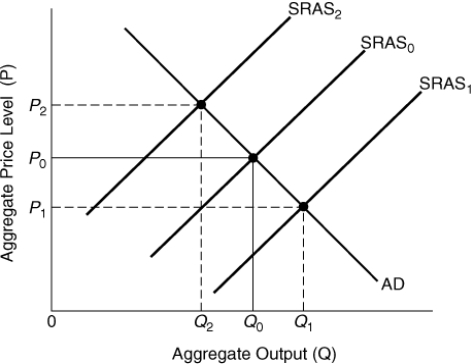A) Adam Smith
B) Karl Marx
C) John Maynard Keynes
D) Milton Friedman
F) A) and D)
Correct Answer

verified
Correct Answer
verified
Multiple Choice
In the short run, a decrease in market power (or monopolization) :
A) will increase the price level.
B) will decrease the price level.
C) will not affect the price level.
D) will not affect output.
F) A) and B)
Correct Answer

verified
Correct Answer
verified
True/False
Cost-push inflation occurs when aggregate demand expands so much that equilibrium output exceeds full employment output.
B) False
Correct Answer

verified
Correct Answer
verified
True/False
One reason the price level did not rise after the 2008-2009 stimulus policy actions is that it may not have shifted aggregate demand to the right.
B) False
Correct Answer

verified
Correct Answer
verified
Multiple Choice
The _____ effect is a reason for the negative slope of the aggregate demand curve.
A) income
B) substitution
C) interest rate
D) multiplier
F) A) and B)
Correct Answer

verified
Correct Answer
verified
Multiple Choice
The Great Depression showed that the short-run aggregate supply and the aggregate demand curves:
A) must always intersect at full employment.
B) can intersect at output levels below full employment.
C) must intersect at output levels above full employment.
D) can never lead to deflation.
F) B) and D)
Correct Answer

verified
Correct Answer
verified
True/False
An increase in productivity, a decrease in taxes, and reduced regulation all shift aggregate supply to the right.
B) False
Correct Answer

verified
Correct Answer
verified
Multiple Choice
Aggregate supply increases when:
A) input prices rise.
B) subsidies are reduced.
C) there is a decrease in firms' market power.
D) business expectations tend toward the negative.
F) All of the above
Correct Answer

verified
Correct Answer
verified
Multiple Choice
When the price of a product falls, causing consumers to purchase more of that product and less of other products, this is known as the:
A) income effect.
B) substitution effect.
C) wealth effect.
D) interest rate effect.
F) All of the above
Correct Answer

verified
Correct Answer
verified
True/False
When interest rates drop, investment will increase and the aggregate demand curve will shift to the right.
B) False
Correct Answer

verified
Correct Answer
verified
True/False
The market does not necessarily clear in the long-run macroeconomic equilibrium.
B) False
Correct Answer

verified
Correct Answer
verified
Multiple Choice
(Figure: Determining SRAS Shifts) Which statement is NOT correct? 
A) Equilibrium output is $3,000 worth of goods and services.
B) An increase in aggregate demand would lead to deflation.
C) Full employment occurs when the economy produces $3,000 worth of goods and services.
D) In the short-run equilibrium, output can be greater than or less than $3,000.
F) B) and C)
Correct Answer

verified
Correct Answer
verified
Multiple Choice
As the aggregate price level declines:
A) there is a movement down along the aggregate demand curve.
B) the aggregate demand curve shifts to the left.
C) there is a movement up along the aggregate demand curve.
D) the aggregate demand curve shifts to the right.
F) A) and C)
Correct Answer

verified
Correct Answer
verified
Multiple Choice
Ceteris paribus, the multiplier effect would be largest in which of the following situations?
A) when prices are fixed
B) when prices are flexible
C) when the government borrows from its citizens to cover increased deficit spending
D) when the government has a balanced budget
F) A) and D)
Correct Answer

verified
Correct Answer
verified
True/False
The aggregate supply curve shows that the price level and real GDP are indirectly related.
B) False
Correct Answer

verified
Correct Answer
verified
True/False
One reason the price level did not rise after the implementation of the 2008-2009 stimulus policy actions is that the U.S. capacity was fully utilized.
B) False
Correct Answer

verified
Correct Answer
verified
Multiple Choice
In macroeconomics, the long run is:
A) a period long enough that participants in the economy will have enough time to gain all relevant information but not enough time to act correctly on that information.
B) the same period accountants use to measure long-term assets and liabilities.
C) a period long enough that participants in the economy will have enough time to gain all relevant information and enough time to act correctly on that information.
D) a period long enough that participants in the economy will have enough time to act correctly on all relevant information but not enough time to collect all of it.
F) A) and C)
Correct Answer

verified
Correct Answer
verified
Multiple Choice
If the national incomes of foreign countries fall at the same time the dollar appreciates, then in the United States, the aggregate demand curve:
A) shifts to the right.
B) shifts to the left.
C) remains unchanged.
D) does not shift, but there is movement up along it.
F) C) and D)
Correct Answer

verified
Correct Answer
verified
Multiple Choice
Which of the following will shift the short-run aggregate supply curve to the right?
A) an increase in the minimum wage
B) an increase in immigration from other countries
C) an increase in the price of oil
D) an increase in the actual price level
F) B) and D)
Correct Answer

verified
Correct Answer
verified
Multiple Choice
The _____ measure(s) the proportion of additional income that consumers spend.
A) spending multiplier
B) marginal propensity to consume
C) marginal propensity to save
D) spending multiplier, the marginal propensity to consume, and the marginal propensity to save
F) B) and C)
Correct Answer

verified
Correct Answer
verified
Showing 201 - 220 of 284
Related Exams